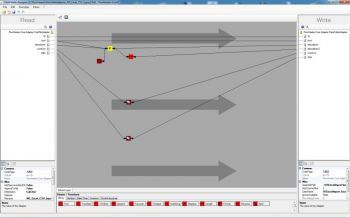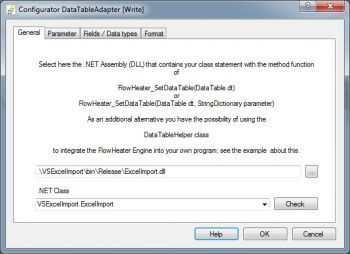MS Excel CSV import using VB.NET
Warning : The DataTable Adapter is outdated and no longer being developed. All the transformations described here can now be carried out better and more easily by using integrated data Adapters.
This describes a brief Visual Basic .NET example to illustrate how the .NET DataTable Adapter can be used to integrate any data source and target in FlowHeater. Of course the example is also provided as Visual Studio Solution source code.
.NET DataTable Excel CSV import
Note: This example only serves as a demonstration. In fact this Excel import/export would be much simpler using with the Excel Adapter alone. If you want to repeat this example you will need Microsoft Excel 97 (or above) installed on your computer.
.NET DataTable Adapter configurator
Once you have opened this example’s Definition, the screen should look something like the screenshot above. The READ side contains nothing of special note, it simply inputs a small CSV text file called "MS-Excel-CSV-Import.txt". Let us inspect the WRITE side’s Configurator. The Excel-Import.dll contains only one Visual Basic .NET function, which stores the data received on the WRITE side at the end of an Excel workbook called "Output.xls". If this workbook does not already exist, it is first created.
Try running this Definition and also inspect the VB .NET source code. You will find the Visual Studio Solution in the directory "Examples\EN\DataTableAdapter\VSExcelImport".
VB.NET Code for the Excel import
If (dt.Rows.Count = 0) Then
' test call from the FlowHeater Designer or nothing to do
Exit Sub
End If
Dim excel As Object
'create Excel object
excel = CreateObject("Excel.Application")
'excel.Visible = True
Dim filename As String
filename = Path.Combine(System.Environment.CurrentDirectory, "Output.xls")
' if not exist create
If File.Exists(filename) Then
excel.Workbooks.Open(filename)
Else
excel.Workbooks.Add()
excel.ActiveWorkbook.SaveAs(filename)
End If
Dim workbook As Object
workbook = excel.ActiveWorkbook
If workbook.Worksheets.Count() = 0 Then
workbook.Worksheets.Add()
End If
Dim worksheet As Object
worksheet = workbook.Worksheets(1)
Dim nRow As Integer
nRow = 1
' search for first free row
Do While True
Dim range As Object
range = worksheet.Cells(nRow, 1)
Dim cellValue As String
cellValue = String.Empty
If range.Value2 <> Nothing Then
cellValue = range.Value2.ToString()
End If
If cellValue.Length() = 0 Then
Exit Do
End If
nRow = nRow + 1
Loop
Dim dr As DataRow
For Each dr In dt.Rows
Dim col As DataColumn
Dim nCol As Integer
nCol = 1
For Each col In dt.Columns
worksheet.Cells(nRow, nCol) = dr(col)
nCol = nCol + 1
Next col
nRow = nRow + 1
Next dr
workbook.Save()
excel.Quit()
End Sub
Microsoft®, Windows®, Excel® are registered trademarks of Microsoft Corporation



